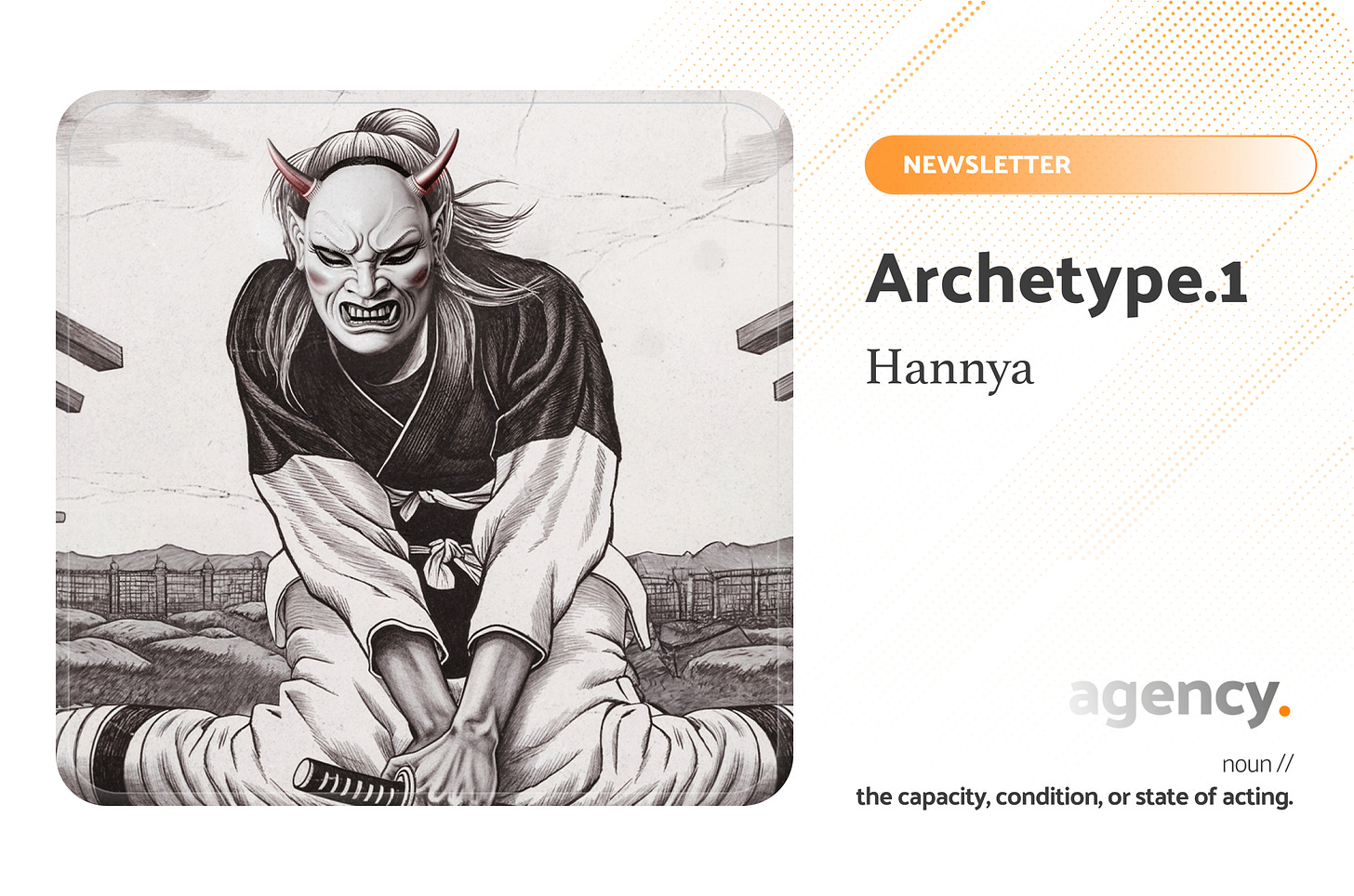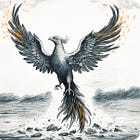Archetype.1 - Hannya
The fury, sorrow and wisdom of a hurt female heart.
0. REPORT: Operation Heartburn
BTP's Classified Hannya Encounter
CLASSIFIED - TOP SECRET
# Bureau of Transcendent Patterns
## Case File: [REDACTED]
### Operation Heartburn: Hannya Encounter Report
#### Date: [REDACTED]
Preamble: This document serves as a preamble to the detailed report concerning Operation Heartburn, executed by the BTP. It provides a classified overview of the encounter and its implications.
WARNING: The information contained in this document is classified as VEILED KNOWLEDGE. Access to this document carries diligent responsibility.
On [REDACTED DATE], an agent of the Bureau of Transcendent Patterns (BTP) successfully logged Operation Heartburn, resulting in the documentation of an extraordinary entity, culturally known as a "Hannya" in ancient oriental literature and theatre. This report details the circumstances of the encounter, preliminary findings, and potential instructions in the context of a sighting.
The subject designated HNS-11, was sighted during field research in the southern territory of Brazil, at a cemetery in the [REDACTED LOCATION] city. An Agency agent was scouting the area during nighttime for an anomaly reported by a spectrum analyzer installed in a facility in the estate of [REDACTED LOCATION] when he came across what seemed to be a woman wearing a martial artist’s attire, a Hannya mask and an encased Katana sword. She was mourning at a tombstone when our agent approached - the subject unsheathed the blade as soon as his presence was felt.
Subject HNS-11 regained her posture as soon as she felt threatened by the presence of our agent and stood in a combat stance while waiting for our agent’s reaction. The agent made no further moves besides an attempt to communicate. The subject's name was requested and a reply in Japanese language was given, it was recorded and later transcribed by the research team.
私の名前は般若様です
“My name is Hannya-Sama”
As soon as the reply was given, the subject moved at an unnatural speed towards the agent, who suddenly found himself facing the cold edge of the sword pressed against his throat. The unknown subject got close to his ear and whispered one final thing before knocking him down and disappearing into the shadows of that night.
忠誠が始まると、終わりはありません。そうでなければ、それは忠誠ではありません。
“Once loyalty begins, it never ends. Otherwise it's not loyalty.”
Once the Agent recovered consciousness the next morning, he returned to the headquarters and reported the encounter while providing the audio recordings and a visual description of the subject's appearance.
[The other pages have been torn off from the report…]
1. Introduction
How are you doing reader?
First of all, Happy New Year! We return with more content and are sure 2025 will be rich in discoveries and inspiration.
Welcoooooome back to the Agency!
Today's edition is a further development of our new series “Archetype.#”
Don't forget to check the first edition about the ancient symbolism behind the Phoenix - the archetype that kickstarted this editorial.
Before digging into this edition's archetype, let's discuss why such research is important for creative professionals.
When dealing with storytelling, we must be equipped with references to populate our stories, worlds and artistry with more meaning.
Most symbols either have an origin or are a byproduct of multiple references that already existed but were synthesized into something new by the creativity of a living person.
And so, for example, when an existing being like an eagle is given unnatural characteristics through human expression, like the addition of burning wings, it evolves into a mythological creature with ethereal traits and much more symbolism than the existing reference behind it.
One of the first belief systems known to historians is called “Animism”, it is used in the study of anthropology of religions as a term for the belief system of many Indigenous people.
The true meaning behind the term varies deeply due to different ethnolinguistic and cultural differences. If we were to try a definition, Animism is about believing that everything in nature has a spirit or soul, just like you do - so you treat everything with respect like a friend or a loved one.
The currently accepted definition of animism was only developed in the late 19th century (1871) by Edward Tylor. It is "one of anthropology's earliest concepts, if not the first."
An interesting artefact for us to consider would be the Löwenmensch figurine, also called the Lion-man of Hohlenstein-Stadel, a prehistoric ivory sculpture discovered in a German cave, determined by carbon dating of the layer in which it was found to be between 35,000 and 41,000 years old - one of the oldest-known examples of an artistic representation and the oldest confirmed statue ever discovered.
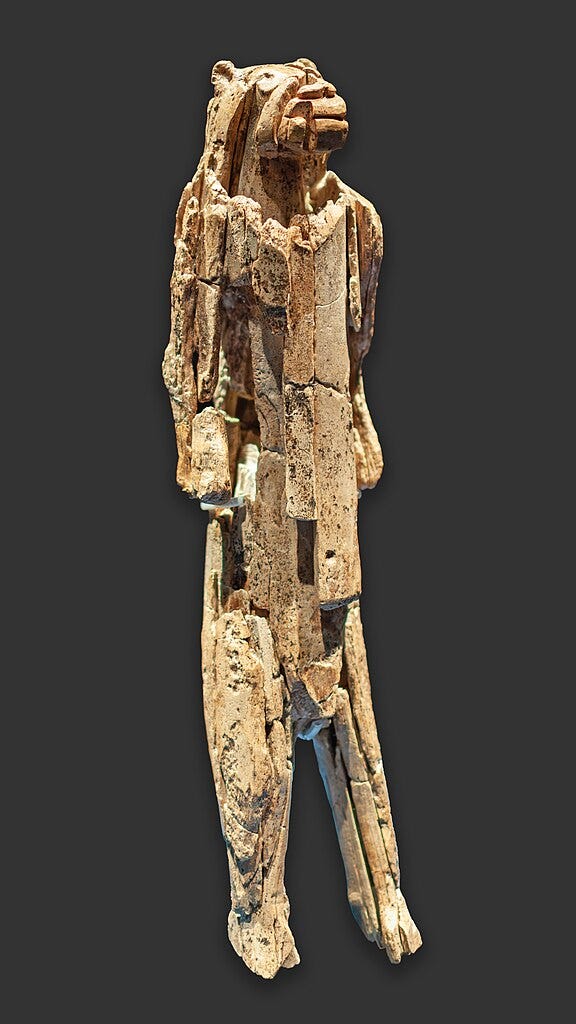
The most interesting thing about it is that it suggests a human-animal spiritual connection through a visual representation of a human-like body with the head of a cave lion, giving us a solid example of how Homo Sapiens already had a sharp imagination and capacity to express ideas back in the Upper Paleolithic era.
Based on that, we can affirm that archetypes have long been following the development of our species and how we interact with the environment and nature around us.
Now let’s tackle the Hannya theme.
2. The Origin of the Hannya
And how sorrow and pain bring evolution.
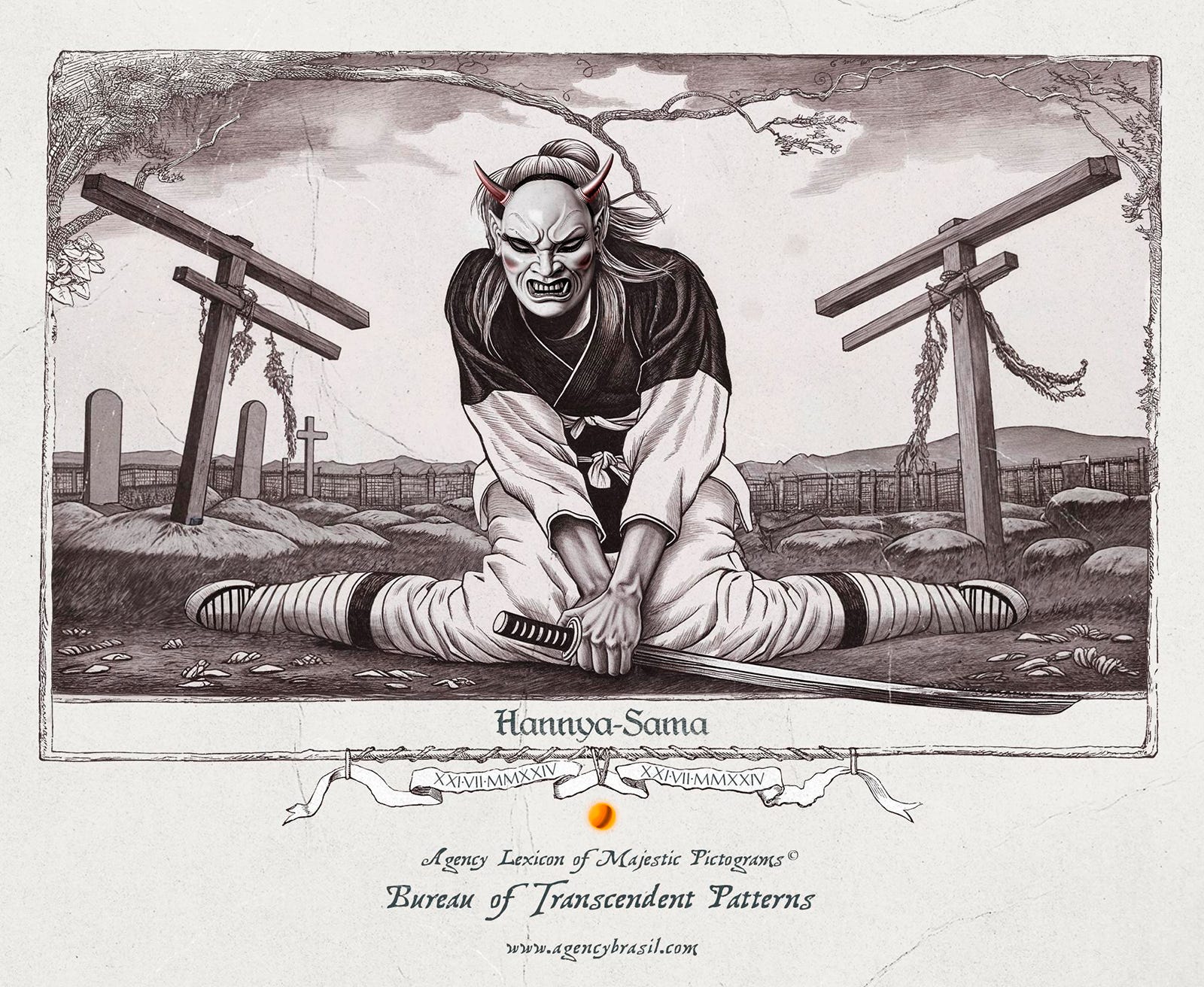
What is there to be said about a mask that represents both the expressions of sorrow and fury?
For us to better understand its meaning, we need to do a quick time travel into the past, specifically during the last Shogunate in the Feudal Japan period, known as the Edo Period (1603-1867).

Shogunates were a political system exclusive to Japan and didn't exist in other Asian nations, they were specifically feudal military dictatorships where loyalty and honour were central to their operation.
It was during the last regime, the Tokugawa Shogunate that the Hannya masks originated in the Noh theatre traditions - a very exclusive art form that was only accessible to the nobility and the samurai class.
Noh continues to be performed today, maintaining many of the same traditions and techniques that were developed during the shogunate periods, making it one of the oldest surviving theatre traditions in the world.
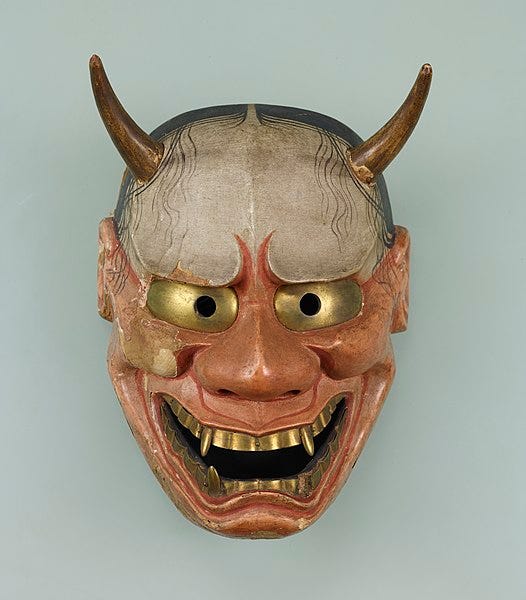
The mask's expression is known to change depending on the angle at which it's viewed - appearing sorrowful when tilted down and frightening when tilted up.
It usually represents a female demon or vengeful spirit, typically depicting a woman who has been consumed by jealousy, rage, or sorrow to the point of transforming into a demon and this is perhaps the most important meaning behind it.
During this period and culture, women's roles were heavily restricted with their primary part being to produce heirs. They couldn't own property in their name, participate in politics and have no legal rights over their children - all while also being subject to easy divorce by their husbands.
The symbolism behind this mask is fundamentally important because it carries a deep heritage of the patriarchal oppression and suppression that women faced back then, which also represented a significant decline in women's rights compared to the Heian period (794-1185), some years before the first Shogunate, which took place around 1192.
The oppression of women represented one facet of the Shogunate's pervasive system of control, which extended across every aspect of society through rigid class hierarchies, economic exploitation, religious persecution, political suppression, and cultural restrictions.
The mask's transformation from a human woman to a demon can be seen as a metaphor for how the strict patriarchal system pushes women to their psychological limits. Its dual nature - showing both beauty and demonic features - reflects the complex reality of women's lives under the shogunate:
The remaining traces of beauty in the mask represent the idealized, submissive role women were expected to maintain
The demonic features (horns, fangs, metallic eyes) symbolize the rage and pain that couldn't be expressed openly in society
The mask's changing expression (sorrowful when tilted down, frightening when tilted up) mirrors how women had to conceal their true feelings while maintaining a proper exterior
In Noh plays, characters wearing Hannya masks often portrayed women who had been:
Abandoned or betrayed by lovers
Displaced from their social position
Forced into unwanted marriages
Separated from their children
Denied their basic rights and dignity
All of this gives us a lot of answers regarding why such a symbol originated from the unconscious collective of Ancestral Japan, where these theatrical pieces suggest a level of cultural acknowledgement of women's suffering, even if it wasn't addressed in reality.
There is though, another very interesting connection I made with the actual name behind the mask that I would like to share: there is some uncertainty and debate around the origin of the name "Hannya." There are several theories about its etymology.
Mask Maker Theory: Attributes the name to Hannya-bō, a skilled mask carver who supposedly created or perfected this type of mask. However, historical evidence for this person is limited.
Linguistic Theory: Some suggest it might be related to the word "han'ya" (半夜), meaning "midnight" or "middle of the night," relating to the supernatural aspects of the mask.
Sanskrit Connection: There's also a theory linking it to the Sanskrit word "prajñā" (wisdom), which was translated into Chinese as 般若 (pronounced "hannya" in Japanese).
But the most interesting relation is to one of a Buddhist context. One theory suggests it comes from "Hannya-shin-kyō" (般若心経), the Japanese name for the Heart Sutra in Buddhism. The character 般若 (hannya) in this context means "wisdom" or "enlightenment."
The Heart Sutra, is one of the most well-known texts in Mahayana Buddhism. Its full name in Sanskrit is the Prajñāpāramitāhṛdaya Sūtra, meaning "The Heart of the Perfection of Wisdom Sutra."
And so, the meaning behind the mask makes a very interesting connection with the duality behind suffering and the wisdom that suffering brings, making them ideas that align well with the Heart Sutra's teachings.
It is a teaching that says everything in the world is connected and always changing, like a sandcastle by the beach. Here’s how it breaks down simply:
Everything is Empty:
Imagine you have a balloon. It looks like it’s “something,” but inside it’s full of air—there’s nothing solid. The sutra says everything in life is kind of like that balloon: it’s real, but it doesn’t stay the same or have a solid “thing” inside.What You See Isn’t the Whole Story:
Just like how a rainbow looks like it’s there but disappears if you try to grab it, everything we see, hear, and feel is part of a bigger, invisible picture.Don’t Worry About Holding On:
The sutra says we feel sad or scared because we try to hold on to things that change, like toys breaking or ice cream melting. If we let go of holding so tight, we won’t feel so afraid or upset.The Magic Words:
At the end, there’s a chant that’s like saying, “Let’s go beyond everything we know and find peace.” It’s a way to remind yourself to not worry too much and just keep moving forward.
It’s all about being okay with things the way they are and not being scared when they change.
Semiotics
Sorrow as Wisdom: The Hannya mask embodies the duality of human suffering—pain that distorts and wisdom that illuminates. It represents how sorrow, though anguishing, can guide individuals toward profound self-awareness and transformation.
Transformation Through Suffering: The mask’s dual expressions—sorrowful and wrathful—symbolize the metamorphic power of emotional pain. It reflects the journey of evolving from suppressed anguish to empowered expression, underscoring the idea that suffering can be a crucible for inner strength and clarity.
Feminine Rage and Resilience: The Hannya is both a victim and survivor, embodying the suppressed fury of women subjected to societal constraints. Its horns and fangs signify the emergence of repressed emotions into a force of reckoning, challenging oppressive systems and reflecting resilience born of adversity.
Duality of the Human Spirit: The Hannya’s shifting visage—gentle from one angle and terrifying from another—represents the complexity of human emotions and identities. It captures the fragile balance between vulnerability and strength, tenderness and fury, beauty and monstrosity.
Enlightenment Through Duality: The connection between "Hannya" and "prajñā" (wisdom) ties the archetype to the Buddhist principle of transcending duality. The mask teaches that true understanding arises from embracing both light and shadow, recognizing suffering not as an endpoint but as a gateway to growth.
Narrative Tools
Character Arc: By depicting a protagonist or an anti-hero burdened by grief, betrayal, or societal injustice. Over time, their anguish transforms into a source of strength, leading them to confront the systems or individuals that caused their suffering.
Example: A woman exiled from her clan for defying tradition reclaims her dignity by using her pain as fuel to reshape her world.Plot Structure: Use a Hannya-inspired moment of transformation as a narrative climax. This could involve the protagonist confronting their inner demons or an antagonist embodying the Hannya archetype revealing unexpected depth.
Example: A village cursed by a vengeful spirit must unravel the source of its pain, realizing the spirit suffered an unjust fate in life. Confronted with their role in its anguish, the community embarks on a journey of atonement to bring peace to both the spirit and themselves.Symbolic Object: Introduce a Hannya mask or artefact as a key symbol in the story. It could represent concealed truths, the duality of a character, or the wisdom gained through suffering.
Example: A cursed mask passed down generations brings misfortune but also grants its bearer insight into their family’s hidden history.Mythical Appearance: Incorporate the Hannya archetype as a supernatural being or force. Use its features—horns, fangs, sorrowful gaze—to depict its complexity and connection to human emotions.
Example: A wandering samurai encounters a Hannya-like demon, only to realize it is the spirit of a woman seeking justice for past wrongs.Themes of Renewal: While the Hannya embodies anguish, its narrative power lies in its potential for renewal. Just as the Phoenix emerges stronger from its ashes, the Hannya archetype invites audiences to explore how pain can lead to rebirth.
Example: A warrior learns to wield the wisdom gained from their deepest regrets to protect those they love, transforming sorrow into a shield against further harm.
The Hannya Warcry
Mythopoesis
In a crib filled with motherly love
whose mother wasn't able to love
a warrior was born
and a new fate was entrusted
with the sharp edges of an oath
made with loath
and broken by mistrust.
A noblewoman in the eyes
with sorrow in demise
and fangs in the night
who protects her kind
with immortality in disguise
Hannya-Sama is her name
a mask is her sword
and the past is her forge
because nothing can ever dry faster
then a salty tear
coming from a sweet eye.
Pandora’s Box
A Fresh Digest on my latest discoveries and some other things.
In the Lenses of Thi
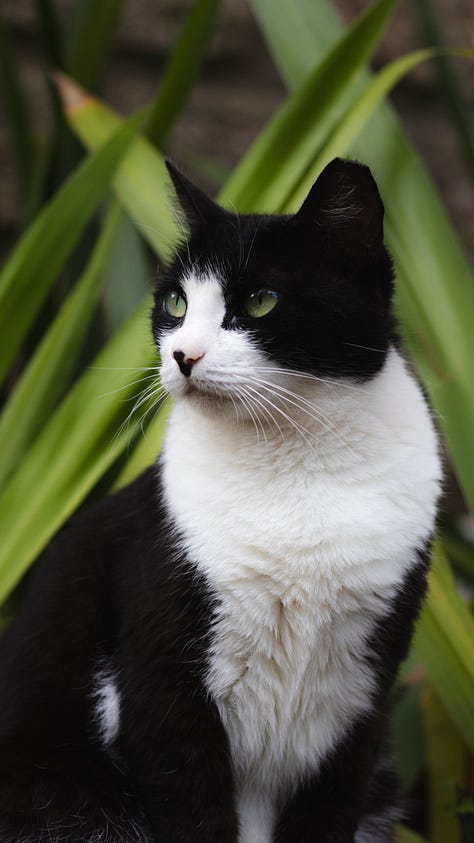




Series 🎥
Truth be told, I had been cooking this issue for around three months. The idea came after watching the new TV series from FX, Shogun. Highly awarded and very well received by critics, this story is a deep dive into feudal Japan that was crafted with mastery and attention to detail.
It is inspired by the story of real people and the most surprising aspect behind it to me was the Lady Miriko character, one of the most inspiring women I have ever seen on the screen.
About the Author
Thiago Patriota
Made in 1996. Born & Raised Brazillian. Bachelor’s Degree in Advertising and Communication. Adept to autodidactism. Curious Soul. Published Author. Founder of Sentient. Co-founder of Agency Brasil. Founder of Astro Bank Brasil
That’s me in a nutshell, but you can learn more about Agency on the About page!



